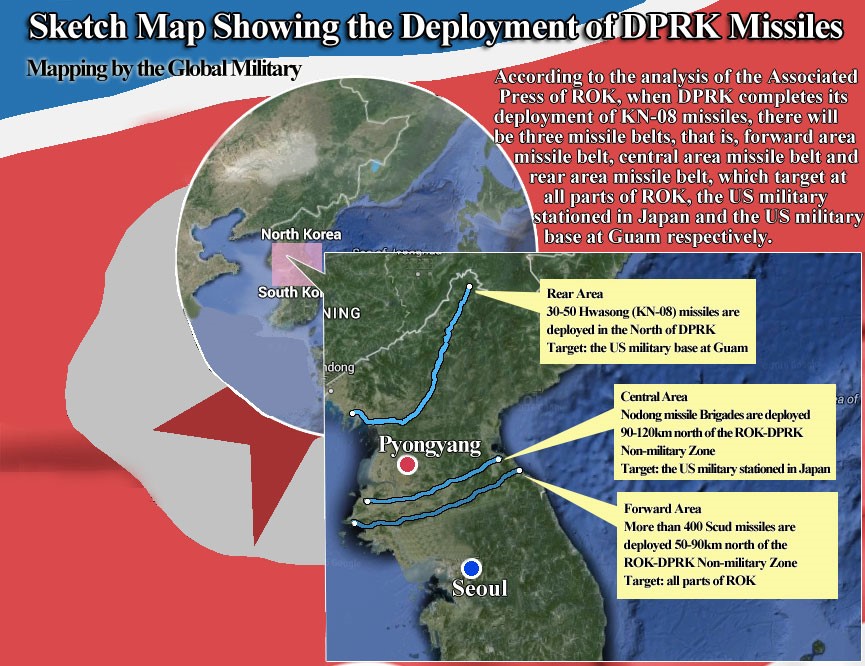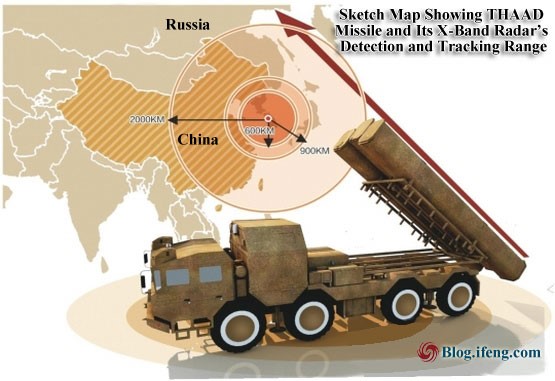In the wake of the DPRK’s fourth nuclear test and launching of a satellite, the US and ROK began to discuss the deployment of the Terminal High-Altitude Area Defense (THAAD) system on Korean soil. On March 23, US Defense Secretary Ashton Carter claimed that the US and the ROK have already reached an agreement in principle to deploy the system in the Korean Peninsula. Is it necessary to deploy THAAD in the ROK? Can THAAD deter the DPRK from attacking the ROK? Let’s see how powerful DPRK’s missiles are, what THAAD can do and what benefits and harms the deployment of THAAD in the Korean Peninsula might produce.
How Powerful Are DPRK Missiles?
According to the Military Balance 2016, the DPRK Army has 6+ Hwasong-13(KN-08, reported operational), ԑ10 Nodong (ԑ90+ msl), some Musudan and KN-02, 30+ Scud-B/Scud-C(ԑ200+msl), 24 Frog-3/5/7. The DPRK Navy has HY-1and KN-01. The DPRK Air Force has Kh-23, Kh-25, R-3, R-60, R-37, PL-5, PL-7, R-23/24, and R-27R/ER. The Army’s missiles are reportedly deployed in three areas: forward, central and rear areas (see the sketch map). From the map we can see that DPRK could employ long-range missiles to attack the US military base at Guam, medium-range missiles to attack the US military stationed in Japan and short-range missiles to attack the ROK. Considering that the types, numbers and capabilities of the DPRK’s short-range missiles are rather limited and the US military has already deployed 30-44 Patriot PAC-3 missile systems in the ROK, it is difficult for the DPRK’s short-range missiles to pose a very grave threat to the ROK. The real, realistic and grave threats to the ROK are the DPRK Army and its 21,100 pieces of artillery, most of which are deployed along the 38°Line and can strike the Seoul area directly.

What Can THAAD Do?
A THAAD battery consists of nine launcher vehicles, each equipped with eight missiles, with two mobile tactical operations centers and an X-Band radar. A THAAD missile weighs 900kg with a length of 6.17m and a diameter of 34cm; it has an operational range of 30-200 km and an altitude range of 15-150 km. Its X-Band radar (AN/TPY-2) can detect and track a conventional ballistic missile within 4000km and a signal-reduced ballistic missile within 2000km. THAAD is designed for high-altitude intercept in a missile’s terminal phase, meaning that it is optimized mostly to defend against medium- and intermediate-range ballistic missiles but is of little or no use against the short- and tactical-range ballistic missiles most likely to be employed against the ROK. Besides, THAAD can do nothing to deal with the real and realistic threats posed by the DPRK’s artillery. Therefore the deployment of THAAD in the ROK is mainly symbolic and can do little to improve ROK’s security environment.
For ROK: Harms Outweigh Benefits
The potential harmful effects of THAAD for the ROK outweigh any potential benefits. The benefits are as follows: It can inflict greater military pressure upon the DPRK and reduce its possibility to take risky actions; it can increase the ROK people’s sense of security and self-confidence; it can strengthen the US-ROK military alliance and enhance their missile-defense capabilities. Negatives may include: the US military will have to expand its military base, which would occupy ROK’s precious land resources; acquisition of THAAD systems (each set costs more than $800 million) requires about $3.2-4.8 billion, which would consume a lot of the ROK defense budget and make it difficult for the ROK to establish its own missile defense system; THAAD will force the ROK to join the US-Japan missile defense system which will impair the ROK’s military initiative; the deployment of THAAD needs at least three to five years, which would not constitute an effective deterrence to DPRK in the short term; the deployment of THAAD will irritate and alienate the DPRK further and further, which would make national unification even more remote; the deployment of THAAD will irritate ROK-China relations, which does not accord with ROK’s national interests.

For the US: Positives Outweigh negatives
The benefits of THAAD in the ROK are clearer for the US. As recently as a few years ago, the US began to sell the idea to deploy THAAD in the ROK. The benefits are as follows: Enhance military presence in the Asia-Pacific region as the US rebalancing strategy requires; consolidate the US-ROK military alliance so as to have a better control of military initiative in the Korean Peninsula; push the bilateral alliance into a multilateral alliance, creating a US-Japan-ROK missile defense system; establish a multi-tier missile system of low, medium and high altitudes together with THAAD, Aegis and Patriot missile systems in Northeast Asia; enhance the US strategic deterrence against China and Russia; facilitate arms trade to please armament corporations and promote the development of the US economy; consolidate its image as an counter-proliferation leader by being firm with the DPRK. The potential harmful effects may include: reducing Sino-American and Russian-American strategic trust, which would make future international cooperation more difficult; breaking the strategic balance in Northeast Asia, which would be detrimental to regional peace and stability; giving rise to regional arms race or even a new cold war, which would be adverse to peace, stability and development of the world.
For DPRK: Greater Military Pressure but Not Much Difference
THAAD’s presence in the ROK would give the DPRK a lot of military pressure but would not make much real difference. The US and ROK have enjoyed overwhelming military superiority over DPRK and DPRK and exerted great military pressure for a long time. With or without THAAD, it is almost the same to the DPRK. Without THAAD, it is not certain that the DPRK would attack the ROK. With THAAD, it is not sure that the DPRK would not attack the ROK. Pyongyang mainly relies upon its powerful artillery and ground forces instead of sophisticated weapons to launch asymmetric operations against the US and ROK forces. Therefore, the kind of action the DPRK might take does not depend upon whether the US and the ROK have deployed THAAD or not.
For China and Russia: National Security Would Be Endangered
THAAD in the ROK would endanger the national security interests of China and Russia. The great detection and tracking distance and high target identification capability of THAAD system would make the military activities and missile launching facilities within China and Russia exposed to the US and the ROK. If the X-Band radar in the ROK were networked with the two X-Band radars in Japan, its capability would be greatly enhanced, which would pose even greater challenges to China’s and Russia’s national security. Besides, THAAD in the ROK would greatly reduce Chinese and Russian strategic deterrence to the US. That’s why China and Russia are firmly opposed to the deployment of THAAD in the Korean Peninsula.
Recommendations
From the analysis above, we can see that if THAAD systems were deployed in the ROK, the US would be the only winner and both Koreas, China and Russia would all be losers. What is more important is that it would reduce strategic trust among the countries concerned and increase uncertainty of security situation in Northeast Asia. To maintain peace and stability in Northeast Asia, I would like to recommend:
DPRK should give up its ambition to get nuclear weapons, carry out all resolutions made by the UN Security Council (UNSC) and come back to the Six-party Talks to seek better ways to ensure its national security. Perhaps Iran can serve as a good example.
The ROK should understand China’s and Russia’s misgivings about THAAD, drop the idea to deploy THAAD and cooperate with the countries concerned in an effort to force DPRK to abandon its nuclear project and mitigate the tense situation in the Korean peninsula.
The US should learn some lessons from the Cuba missile crisis and NATO’s eastward expansion, understand and respect other countries’ security concerns, and take some concrete measures to ease instead of aggravating the tension in the Korean Peninsula.
China and Russia should increase communications with the US, the ROK and the DPRK to make their security concerns understood, consolidate cooperation with other UN members in the process of UNSC resolutions enforcement and adopt more positive steps to promote peace, stability and development in the Korean Peninsula.



